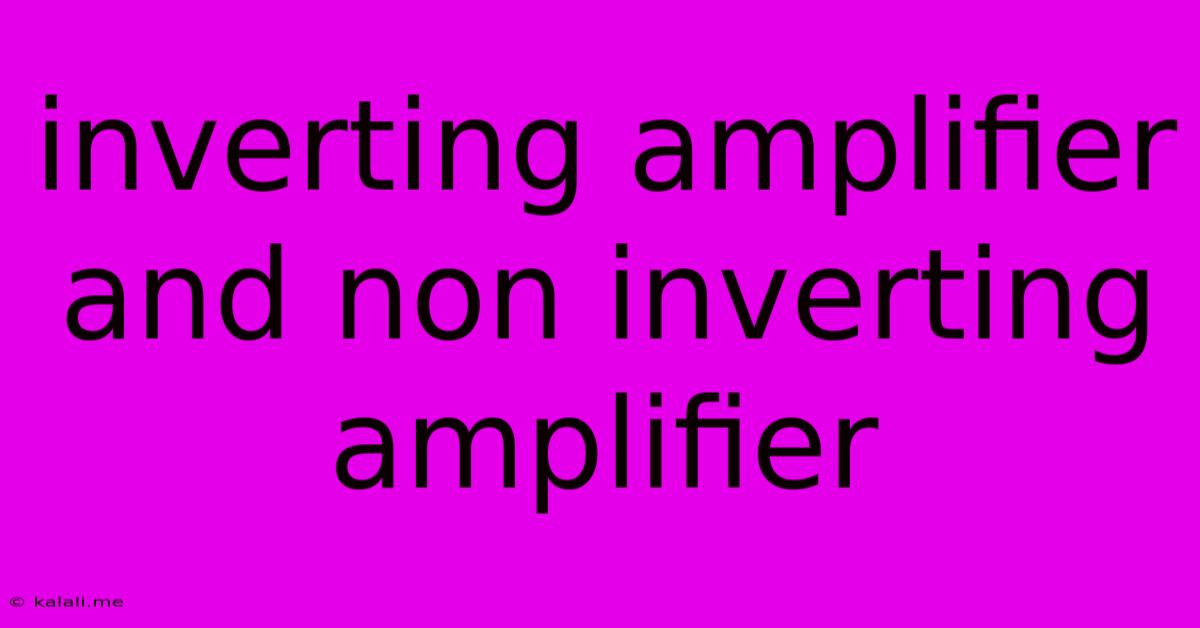Inverting Amplifier And Non Inverting Amplifier
Kalali
Jun 07, 2025 · 4 min read

Table of Contents
Inverting and Non-Inverting Amplifiers: A Comprehensive Guide
Operational amplifiers (op-amps) are fundamental building blocks in analog circuit design, offering versatility in signal amplification and processing. This article delves into two crucial op-amp configurations: the inverting amplifier and the non-inverting amplifier, exploring their characteristics, applications, and design considerations. Understanding these configurations is key to mastering op-amp circuitry.
What is an Operational Amplifier (Op-Amp)?
Before diving into specific amplifier types, let's briefly review the op-amp itself. An op-amp is a high-gain, direct-coupled voltage amplifier with high input impedance and low output impedance. It typically has two input terminals: an inverting input (-) and a non-inverting input (+), and one output terminal. The output voltage is a amplified version of the difference between the two input voltages. Ideal op-amps exhibit infinite open-loop gain, infinite input impedance, and zero output impedance, though real-world op-amps approximate these characteristics.
1. The Inverting Amplifier
The inverting amplifier is characterized by its negative feedback configuration, where the output is fed back to the inverting input. This feedback mechanism stabilizes the gain and improves linearity.
How it Works:
The input signal is applied to the inverting input through a resistor (R<sub>in</sub>), while the feedback resistor (R<sub>f</sub>) connects the output to the inverting input. The non-inverting input is grounded (0V). Due to the high open-loop gain of the op-amp, the voltage difference between the inverting and non-inverting inputs is virtually zero (virtual ground). This means the voltage at the inverting input is approximately 0V.
Gain Calculation:
The gain (A<sub>v</sub>) of an inverting amplifier is determined by the ratio of the feedback resistor (R<sub>f</sub>) to the input resistor (R<sub>in</sub>):
A<sub>v</sub> = -R<sub>f</sub> / R<sub>in</sub>
The negative sign indicates that the output signal is 180 degrees out of phase with the input signal – hence the term "inverting."
Key Characteristics:
- High Input Impedance: The input impedance seen by the input signal is approximately equal to R<sub>in</sub>.
- Low Output Impedance: The output impedance is typically low, enabling the amplifier to drive various loads.
- Gain is determined by resistor ratio: This allows for precise gain control.
- Signal Inversion: The output signal is inverted compared to the input signal.
Applications:
Inverting amplifiers are widely used in:
- Signal scaling and attenuation: Adjusting the amplitude of a signal.
- Subtractors: By applying multiple input signals through separate resistors to the inverting input.
- Instrumentation amplifiers: As part of a larger instrumentation amplifier circuit.
- Active filters: Forming the basis of many active filter designs.
2. The Non-Inverting Amplifier
Unlike the inverting amplifier, the non-inverting amplifier applies the input signal to the non-inverting input. The feedback mechanism still uses negative feedback, maintaining stability.
How it Works:
The input signal is applied to the non-inverting input (+). A resistor divider network (R<sub>1</sub> and R<sub>2</sub>) typically provides feedback to the inverting input. The op-amp maintains the voltage at the inverting input equal to the voltage at the non-inverting input.
Gain Calculation:
The gain (A<sub>v</sub>) of a non-inverting amplifier is given by:
A<sub>v</sub> = 1 + (R<sub>2</sub> / R<sub>1</sub>)
Notice that the gain is always greater than 1 (unity).
Key Characteristics:
- Very High Input Impedance: The input impedance is extremely high, making it ideal for high-impedance sources.
- Low Output Impedance: Similar to the inverting amplifier.
- No Signal Inversion: The output signal is in phase with the input signal.
- Gain is always greater than unity: Provides voltage amplification.
Applications:
Non-inverting amplifiers find use in:
- Voltage buffers: To isolate a high-impedance source from a low-impedance load without significant signal attenuation (unity-gain buffer).
- High-impedance sensor interfacing: Amplifying signals from devices like microphones or photodiodes.
- Summing amplifiers: When multiple signals are summed together.
- Comparators: Forming the core of comparators.
Conclusion:
Both inverting and non-inverting amplifiers are essential components in countless electronic systems. The choice between them depends on the specific application requirements, particularly whether signal inversion is desired and the input impedance considerations. A thorough understanding of their operational principles and characteristics is crucial for effective analog circuit design.
Latest Posts
Latest Posts
-
Locus Of Points Equidistant From A Point And A Circle
Jun 07, 2025
-
How To Find Out Where A Transaction Came From
Jun 07, 2025
-
How Do You Say Pecan In Spanish
Jun 07, 2025
-
Burning A Candle At Both Ends
Jun 07, 2025
-
Can You Do Nikah Without Parents
Jun 07, 2025
Related Post
Thank you for visiting our website which covers about Inverting Amplifier And Non Inverting Amplifier . We hope the information provided has been useful to you. Feel free to contact us if you have any questions or need further assistance. See you next time and don't miss to bookmark.